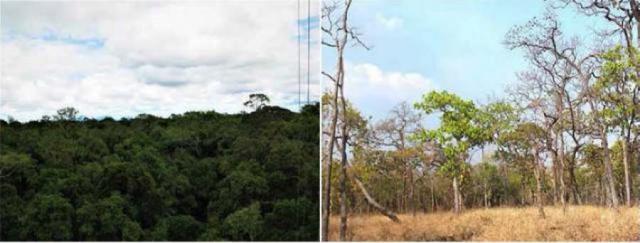Home > Research > Research Results > Research Results 2017 > Wood density and water content of dry tropical forest do not differ with different forest types and tree sizes
Update:December 22, 2017
Main content starts here.
Wood density and water content of dry tropical forest do not differ with different forest types and tree sizes
| Article title |
Comparison of wood density and water content between dry evergreen and dry deciduous forest trees in central Cambodia |
|---|---|
| Author (affiliation) |
Kenzo Tanaka (a), Makoto Sano (b), Reiji Yoneda (c), Sophal Chann (d) (a) Department of Plant Ecology, FFPRI, Tsukuba, Ibaraki, Japan. (d) Forestry Administration, Cambodia. |
| Publication Journal |
Japan Agricultural Research Quarterly (JARQ), 51(4):363-374, 2017, DOI: 10.6090/jarq.51.363( External link ) |
| Content introduction |
The wood density and water content of trees are closely correlated with various functional traits such as growth rate and drought tolerance and are critical for evaluating or modeling the functions of forest ecosystems such as the carbon cycle. Although different forest types and tree sizes (tall canopy trees and small understory trees) in tropical rainforests show differences in wood density and water content, such data of dry tropical forests of Southeast Asia are scarce. To identify differences in wood density and water content with regard to different forest types and different tree sizes in dry tropical forests, we conducted this study in dry deciduous forests and dry evergreen forests in Cambodia. The wood density and water content did not differ between the two forest types, and the both traits did not differ among different-sized trees of the same species. Wood density of tall canopy trees in humid tropical rainforests was lower than that of small understory trees; however, that of tall canopy trees and small understory trees in tropical dry forests was high in both deciduous and evergreen forests. The higher wood density of tall trees, particularly those in dry evergreen forests where canopy trees had a height of 40 m, may help in overcoming the vertical increment of drought stress through strong negative pressures. The characteristics of the wood of the various species assessed in this study were indispensable for improving the accuracy of the estimates of forest biomass and were useful for evaluating the drought tolerance between species.
Photo. Left: Dry evergreen forest at the beginning of the dry season.Tree heights in the dry evergreen forest reached approximately 40 m. The soil in dry evergreen forests can be as deep as 10 m, and evergreen foliage is maintained during the rainless dry season as the foliage use moisture stored in the deep soil, enabling endurance of the harsh dry season.Right: Dry deciduous forest during the second half of the dry season. In the deciduous forest, the trees are sparse and only reach heights of approximately 20 m. Photosynthesis and transpiration actively continue for a time while the trees endure the drought, but the moisture stored in the thin soil is exhausted within few months, and the trees shed their leaves. |
Copyright © Forest Research and Management Organization. All rights reserved.

